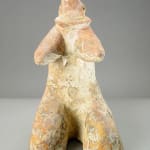Tenenkun Terracotta Seated Zoomorphic Sculpture, 12th Century CE - 14th Century CE
Terracotta
PF.2415 (LSO)
Further images
This remarkable zoomorphic sculpture was made by the Tenenku people, a unit within the mediaeval Malian Empire. It is a highly unusual variant. Most such works are vaguely equine in...
This remarkable zoomorphic sculpture was made by the Tenenku people, a unit within the mediaeval Malian Empire. It is a highly unusual variant. Most such works are vaguely equine in appearance, but this imposing piece represents a less instantly recognisable animal, seated with outstretched arms and with its face turned upwards. The legs are large and strongly flexed, and the arms short and stubby. The face is nugatory and comprised of incised and impressed lines. The surface of the clay is unadorned; the tone of the clay is lighter than usual, although the patina is still good with irregular patches of gray and white. The identity of the animal is somewhat obscure, although the collar would suggest domestication.
The Mali (or Malian) Empire spans about 400 years from the early 13th century. It began as a small city-state just south of the Ghana Empire in the 11th-12th centuries, then united numerous smaller kingdoms under Islam. At its height, it stretched across modern-day Mali and Northern Guinea – controlling about 500,000 square miles – with further influence across West Africa. Only the Mongol Empire was larger. Almost all Malian emperors trace their ancestry back to Bilal, Mohammed’s personal Muezzin, one of whose seven sons is said to have settled in the area. Wealth was accumulated through taxation and trade, and the control of gold mining. Copper and salt were used as currency within – and beyond – the empire. The wealth of the empire was such that Mali was put on the world map. Following their collapse, much of their territory was inherited by the Bamana/Bambara people.
Numerous cultures were absorbed or created by the empire, including the Bura, the Djenne, the Koma, the Bankoni the Djenneke and the Tenenku. The outstandingly diverse range of material culture reflects this fact. However, the fact that they were technically social isolates within the Malian hegemony means that there is little historical information about these cultures, a situation that has been exacerbated by the plundering of archaeological sites for their often outstanding artistic products.
This piece is totally obscure insofar as function is concerned. Identifying its intended usage is thus an exercise in ethnographic surmise. If a horse, it may reflect a reflection of wealth or an aspirational aim, for horses are traditionally owned by social elites. It could thus be a religious or devotional piece (such as an altar), an offering, or perhaps a figure used in magico- religious rituals to attract prosperity. Alternatively it could be made purely for a grave offering to accompany the deceased into the afterlife. Whatever its significance, it is a striking and powerful piece of ancient African art.
The Mali (or Malian) Empire spans about 400 years from the early 13th century. It began as a small city-state just south of the Ghana Empire in the 11th-12th centuries, then united numerous smaller kingdoms under Islam. At its height, it stretched across modern-day Mali and Northern Guinea – controlling about 500,000 square miles – with further influence across West Africa. Only the Mongol Empire was larger. Almost all Malian emperors trace their ancestry back to Bilal, Mohammed’s personal Muezzin, one of whose seven sons is said to have settled in the area. Wealth was accumulated through taxation and trade, and the control of gold mining. Copper and salt were used as currency within – and beyond – the empire. The wealth of the empire was such that Mali was put on the world map. Following their collapse, much of their territory was inherited by the Bamana/Bambara people.
Numerous cultures were absorbed or created by the empire, including the Bura, the Djenne, the Koma, the Bankoni the Djenneke and the Tenenku. The outstandingly diverse range of material culture reflects this fact. However, the fact that they were technically social isolates within the Malian hegemony means that there is little historical information about these cultures, a situation that has been exacerbated by the plundering of archaeological sites for their often outstanding artistic products.
This piece is totally obscure insofar as function is concerned. Identifying its intended usage is thus an exercise in ethnographic surmise. If a horse, it may reflect a reflection of wealth or an aspirational aim, for horses are traditionally owned by social elites. It could thus be a religious or devotional piece (such as an altar), an offering, or perhaps a figure used in magico- religious rituals to attract prosperity. Alternatively it could be made purely for a grave offering to accompany the deceased into the afterlife. Whatever its significance, it is a striking and powerful piece of ancient African art.





